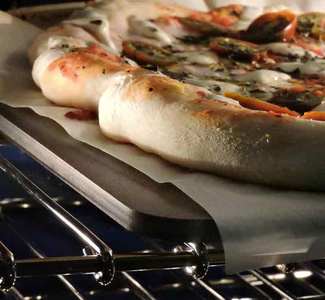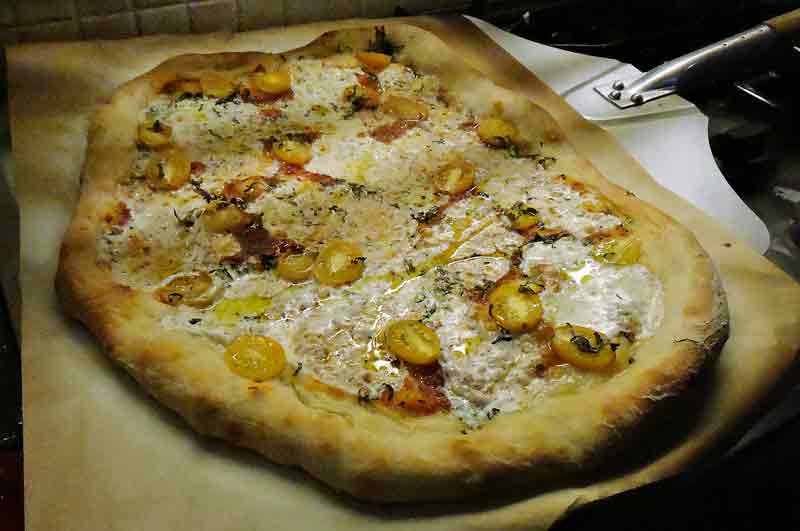|
As you might have read in my post, Pizza Woes: New Wall Ovens and The Learning Curve to Make Perfect Pizzas, we have new double wall ovens--from Kitchenaid... with a conventional oven on the bottom and a convection unit above. Since we got them I've been having problems getting enough heat to bake my pizzas properly--and quickly. I've narrowed the problem down to a simple fact of physical science: Our old oven had a 50 amp breaker and used almost 44 amps of electric power to heat its exposed thermal elements. The new ovens require only a 40 amp circuit breaker for its lower covered heating element and uses only 33 amps of power. The problem is the old ovens heated faster and more intensely. The new ovens take a long time to preheat and seem to fluctuate as much as 80 degrees as the thermostat tries to keep the oven at the temperature I've set on the control panel. The rear of the ovens are also 25-35 degrees hotter than the front... this is due to the fact that the glass on the doors is one of the largest I've seen on wall ovens.. that much glass simply does not hold the heat as much as an oven door with a smaller window. So, I've tried a few things to help my pizzas bake faster and more evenly. First I tried a double stone technique--where you place one stone under your pizza and another on the rack just above the lower one. Supposedly this is supposed to radiate heat downwards as well as upwards toward the pizza. I didn't see any difference. Since Lisa doesn't like pizzas that are too dark on the bottom, I usually make pizza on my newer, lighter colored, less seasoned stone. Ok, so I tried using my darker, more aged stone. It helped a bit, but my normal bake time for a pizza placed right on the stone (I use parchment underneath the dough) still were taking almost 20 minutes at 550 degrees F to bake properly. My old oven only went to 515F and finished a pizza baked without a pan in 3-5 minutes! For my pan pizzas I often use a silver steel half sheet pan--a heavy commercial one. I've always gotten great pan pizzas in 15 minutes at 475 degrees F from these pans--the pan placed on the preheated pizza stone. With the new ovens, the bottom of the crust took forever to crisp and brown up. So, I tried changing pans and got a dark colored heavy sheet pan. This worked pretty well. My times came back down to 15 minutes... but sometimes needed a minute on broil to finish cooking the toppings. Ok, I could live with that--pan pizzas are back on track. Now, back to on-the-stone pizzas... I tried the upper oven's convection feature only to find that the rear of the crust burned--a charcoal tasting black. Not good. This seemed to happen no matter what rack I put my pizza stone on--above the rear convection fan or at the bottom. I typically bake rectangular pizza shapes so turning the thing halfway through baking would be awkward and potentially dangerous.  The pizza on the steel after about 2 minutes The pizza on the steel after about 2 minutes A Solution (or rather, a compromise) Well, I think I've found a secret weapon to solve some of these problems. The pizza steel. It was a bit hard to decide on the perfect one... most are made of a carbon steel and have to be seasoned. Most are also smaller than a standard 14" x "16" pizza stone, too. The Nerd Chef Pizza Steel was the right size but a bit expensive at $80 on Amazon. I ordered one and got right to pizza making... First of all, this steel is heavy. I mean HEAVY. I think it's about 25 pounds. The steel isn't black. It's a dark grey, textured steel. It didn't need seasoning. Here's the science behind it. All things transfer heat at different rates. Take air, for instance. Air is terrible at heat transfer. That's the reason we can momentarily place our hand into a very hot oven and not get burned. But touch the metal of the oven rack and we'll get a serious burn. The heat transfers from the metal very, very fast. This pizza steel transfers heat about 20 times more efficiently than a ceramic pizza stone. This also makes it heat up to temperature quicker--and stay at that temperature with less fluctuations. How did it work? Well, you be the judge. The photo above shows the finished product... The oven was pre-heated for 45 minutes, the temperature was set to 550F, and I got a a 5 minute pizza! The crust was crisp. It gave a nice thud when I flicked a finger under it. My laser thermometer showed the temperature was a bit more even from front to back... perhaps only a 15-20 degree difference. I used parchment under my dough... sliding it off my wooden peel along with the pizza as I slid it onto the steel. No need to oil or season the steel. I'm sure it will stay cleaner this way too, as the parchment keeps any spills from getting onto the steel. I did two pizzas, one right after the other with about a 3 minute gap in between. As I prepped the second pizza, the steel had time to get back to temperature again. (Pizza stones tend to cool down if you do one pizza after the other).
So, problem solved. I still am not crazy about my new ovens, but at least I've found an acceptable workaround. BTW, if you decide to get a pizza steel, just be careful about never touching it when it's hot. Give it a very long time to cool down and perhaps crack the oven door open a bit after you're done making your pizza. This thing is so heavy that I'm leaving it in the oven even when cooking other things. I'm going to try it for bread also, but I'm thinking it might brown the bottom of a bread a bit too much. I'll let you know... Ciao! --Jerry Finzi UPDATE: Since I originally wrote this, I have used my steel at least once a week, I have some other observations...
Please, stop by our SURVEY and spend 60 seconds telling us how we could make our blog better! Grazie! You can also follow Grand Voyage Italy on: Google+ StumbleUpon Tumblr
6 Comments
5/26/2021 04:36:19 am
I guess, OTG Ovens are great for baking and grilling stuff like these at home.
Reply
Your comment will be posted after it is approved.
Leave a Reply. |
Categories
All
Archive
June 2024
|





 RSS Feed
RSS Feed
